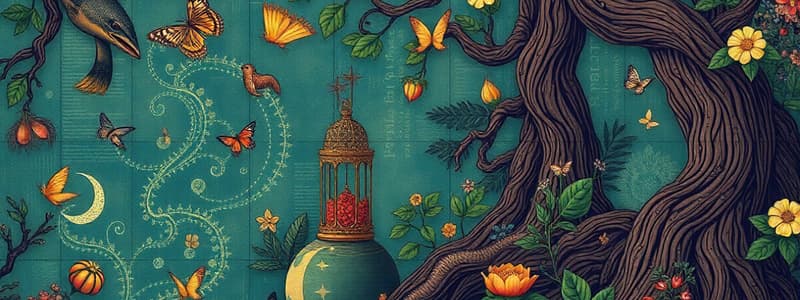Podcast
Questions and Answers
¿Cuál es una función principal de los ciclos biogeoquímicos en el medio ambiente?
¿Cuál es una función principal de los ciclos biogeoquímicos en el medio ambiente?
- Reducir la biodiversidad
- Aumentar la contaminación
- Eliminar especies invasoras
- Reciclar nutrientes esenciales (correct)
En una cadena trófica, ¿qué representa un consumidor primario?
En una cadena trófica, ¿qué representa un consumidor primario?
- Un depredador en la cima
- Un descomponedor en el ciclo
- Un organismo que se alimenta de productores (correct)
- Un organismo que produce su propio alimento
¿Qué tipo de interacción ocurre cuando un organismo se beneficia y otro no resulta afectado?
¿Qué tipo de interacción ocurre cuando un organismo se beneficia y otro no resulta afectado?
- Parasitismo
- Depredación
- Competencia
- Comensalismo (correct)
¿Cuál de los siguientes elementos NO es parte de un ciclo biogeoquímico?
¿Cuál de los siguientes elementos NO es parte de un ciclo biogeoquímico?
En una cadena trófica, ¿qué rol cumplen los descomponedores?
En una cadena trófica, ¿qué rol cumplen los descomponedores?
Flashcards
Ciclos biogeoquímicos
Ciclos biogeoquímicos
Son procesos donde los elementos químicos circulan entre los seres vivos y el medio ambiente.
Cadena trófica
Cadena trófica
Es la secuencia de organismos que se alimentan unos de otros en un ecosistema.
Productores
Productores
Organismos que producen su propio alimento, como las plantas.
Consumidores
Consumidores
Signup and view all the flashcards
Descomponedores
Descomponedores
Signup and view all the flashcards
Study Notes
Ciclos Biogeoquímicos
- Biogeochemical cycles are the continuous flows of elements like carbon, nitrogen, and water between the living (biotic) and non-living (abiotic) parts of the environment.
- These cycles are essential for life because they continuously recycle essential nutrients.
- The water cycle involves evaporation, condensation, precipitation, and collection, moving water through the atmosphere and on Earth's surface.
- The carbon cycle involves the movement of carbon through the atmosphere, oceans, and living organisms. Photosynthesis and respiration are key processes in this cycle.
- The nitrogen cycle involves the conversion of nitrogen gas into usable forms for plants, animals, and decomposers. Bacteria play a vital role in these conversions.
- Examples of cycles include the water cycle, carbon cycle, oxygen cycle, nitrogen cycle, and phosphorus cycle.
Cadenas Tróficas
- A food chain shows the transfer of energy from one organism to another in an ecosystem.
- It begins with producers (plants), followed by consumers (herbivores, carnivores, omnivores), and ends with decomposers.
- Producers make their own food through photosynthesis.
- Herbivores eat plants.
- Carnivores eat other animals.
- Omnivores eat both plants and animals.
- Decomposers break down dead organisms, returning nutrients to the soil.
- For example: Sun → Plant (producer) → Rabbit (herbivore) → Fox (carnivore) → Decomposers.
- Each step in a food chain is a trophic level.
Interacciones entre organismos
- Organisms in an ecosystem interact in various ways, affecting populations and communities.
- Competition occurs when organisms strive for the same resources, like food or territory.
- Predation occurs when one organism hunts and kills another for food.
- Symbiosis involves close interactions between different species.
- Mutualism is a symbiotic interaction where both species benefit, like bees and flowers.
- Commensalism is a symbiotic interaction where one species benefits and the other is neither harmed nor helped, like barnacles on a whale.
- Parasitism is a symbiotic interaction where one species (parasite) benefits at the expense of another (host), like a tick on a dog.
- These interactions are important because they shape and maintain the balances and diversity in ecosystems.
Studying That Suits You
Use AI to generate personalized quizzes and flashcards to suit your learning preferences.




